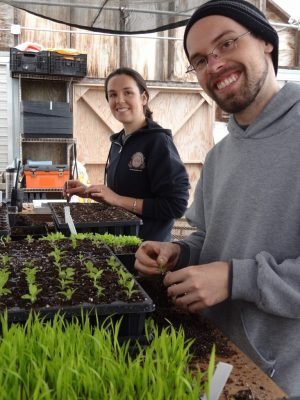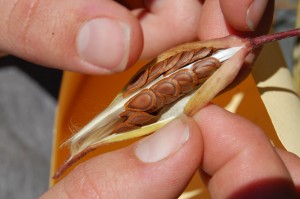Local Hero Profile: Nasami Farm Native Plant Nursery
By Jenny Miller Sechler
Published in the CISA May 2014 ENewsletter
 The drive to Nasami Farm in Whately winds its way through wooded groves and open fields, and the farm itself lies on 75 beautiful acres of forest, meadow, and stream. Visitors to the farm are sure to appreciate the serene landscape as well as the nursery’s wide selection of native perennials, trees, shrubs, and ferns. But closer observers may notice details that set Nasami Farm apart from other nurseries, like a display map of New England’s ecoregions, and brochures with information on classes covering everything from tree care basics to seed saving. These details reveal that Nasami Farm is not only in the business of horticulture. It is in the business of conservation. As part of New England Wild Flower Society, Nasami’s mission is “to conserve and promote the region’s native plants to ensure healthy, biologically diverse landscapes.” The conservation mission is reflected in the care, attention, and sensitivity the growers at Nasami give to every species in their care.
The drive to Nasami Farm in Whately winds its way through wooded groves and open fields, and the farm itself lies on 75 beautiful acres of forest, meadow, and stream. Visitors to the farm are sure to appreciate the serene landscape as well as the nursery’s wide selection of native perennials, trees, shrubs, and ferns. But closer observers may notice details that set Nasami Farm apart from other nurseries, like a display map of New England’s ecoregions, and brochures with information on classes covering everything from tree care basics to seed saving. These details reveal that Nasami Farm is not only in the business of horticulture. It is in the business of conservation. As part of New England Wild Flower Society, Nasami’s mission is “to conserve and promote the region’s native plants to ensure healthy, biologically diverse landscapes.” The conservation mission is reflected in the care, attention, and sensitivity the growers at Nasami give to every species in their care.
Founded as the Society for the Protection of Native Plants in 1900, New England Wild Flower Society is the oldest plant conservation organization in the United States. “It was started by a group of women who were concerned about people going into the woods, digging up native plants and putting them out for sale,” describes Cayte McDonough, Nasami’s nursery manager. “They were trying to educate people that these plants are not limitless resources.” From this simple start, New England Wild Flower Society evolved into a leader in native plant conservation, horticulture, and education. The Society’s education department offers classes to adults and children. Its conservation department tracks, monitors, and works to conserve rare species of plants throughout New England, and identifies and manages invasive plants. The Society maintains a native plant botanical garden, Garden in the Woods, at its headquarters in Framingham, Massachusetts, and in 2003, the Society purchased Nasami Farm in Whately to serve as a nursery for native plants.
Nasami Farm sets itself apart from most nurseries in several ways. Not only do they focus on providing native plants, but they do so from seed that has been sustainably collected locally in the wild. In contrast, most nurseries grow plants via vegetative production methods, which results in identical plants, which can limit the conditions it is adapted to and how well each clone will stand up to disease. By starting with seed collected in the wild, Nasami can offer genetically diverse plants that are well adapted to our local conditions, making them more likely to thrive in the natural environment.
 “Collecting seeds is quite a process,” notes McDonough, one that depends on serendipity, word of mouth, and careful observation. Starting with a core list of over 300 plant species and knowledge of typical plant communities, the staff and volunteers of New England Wild Flower Society look everywhere and anywhere they can—provided they have permission to walk the land. While regulations prevent people from collecting seeds in state forests and parks, creative volunteers search for plants on land owned by towns, land trusts, and utility companies as well as land owned by themselves or friends and neighbors. “For each species we look for a good-sized population, at least 50 plants,” notes McDonough. Seed collectors minimize their impact on plant populations by limiting their harvest to 20 percent of the available seed.
“Collecting seeds is quite a process,” notes McDonough, one that depends on serendipity, word of mouth, and careful observation. Starting with a core list of over 300 plant species and knowledge of typical plant communities, the staff and volunteers of New England Wild Flower Society look everywhere and anywhere they can—provided they have permission to walk the land. While regulations prevent people from collecting seeds in state forests and parks, creative volunteers search for plants on land owned by towns, land trusts, and utility companies as well as land owned by themselves or friends and neighbors. “For each species we look for a good-sized population, at least 50 plants,” notes McDonough. Seed collectors minimize their impact on plant populations by limiting their harvest to 20 percent of the available seed.
Once the seeds have been collected, volunteers help clean them, sow the seed, and nurture the seeds through germination. These steps also require careful attention, and listening to McDonough describe each plant’s unique way of developing can feel a little bit like listening to a parent describe her child. “Some need to be sown right away,” explains McDonough. “With some species, the sown seeds require multiple years and a series of cold and warm cycles before they’ll germinate. A plant may send out a root in the first year, then the next year, maybe they’ll put up one leaf.” For instance, trillium, a common and beloved New England plant, takes 5-7 years to produce a flower. Some seeds need help germinating, like the seeds of the sundial lupine, another beautiful, native flower, which need to be scarified by lightly scraping with sandpaper. This helps break down the hard seed coat, enabling the seed to absorb water and germinate.
Nasami focuses on seed propagation, and the farm works with partner nurseries to grow out young plants. Partner nurseries buy plugs from Nasami at wholesale and grow them to commercial size. They then sell the plants back for use in the retail operations at Nasami and Garden in the Woods. The partners also keep plants for their own nurseries, thus increasing the availability of healthy native species. “Keeping the focus on propagation allows us to direct energy toward collecting wild seed and is more true to our mission of conserving and promoting biological diversity,” explains McDonough. In addition to working with partner nurseries, Nasami is actively involved in conservation efforts across New England. For instance, The U.S. Department of Fish and Wildlife contracted with Nasami to grow a species of goldenrod as part of its project to increase habitat for the endangered roseate tern on Monomoy National Wildlife Refuge.
“Native plants are the foundation of the food chain. Insects feed on the plants and bird species feed on the insects. Native pollinators rely on the pollen and nectar. If you lose the foundation, the whole thing can collapse,” says McDonough. This statement is only common sense, yet often the importance of native plants is overlooked in conversations about conservation. New England Wild Flower Society does great work to ensure that plant conservation is part of the discussion, and even more importantly, to conserve and promote the use of native plants. Pioneer Valley residents interested in hearing more are welcome to come to Nasami for a visit, to take in a class, or to purchase plants. Those interested in doing more to encourage the growth of native plants can also purchase a New England Native Plant CSA and pick up four packages of edible and woodland natives to grow themselves. As McDonough notes, “What can be more local than native plants that are grown from seeds collected locally?”

